
June 26, 2019
In the digital world,
it’s essential to free IT’s future from the pull of its past

A tale of two stories at Microsoft
When Steve Balmer became CEO of Microsoft in 2000, the stock was trading at $40.00 a share. When he stepped down as CEO in 2014, the stock was trading at $40.00 a share. During his entire 14 year tenure as CEO of Microsoft, the stock never traded above $40.00 a share.
When Satya Nadella became CEO of Microsoft in 2014, the stock was trading at $40.00 a share. Over his four year tenure as CEO, the stock has increased over 300% and is now trading at $130.00 a share.
What caused this dramatic change in Microsoft’s stock price? It was Satya’s ability to free the company’s future from the pull of its past. He did that by pivoting the company from an on-premise, on-desktop business model to a cloud-first, mobile-first business model. He complemented that pivot with a shift from a predatory competitive strategy to a collaborative partnership ecosystem strategy.
What are the lessons learned for CIOs
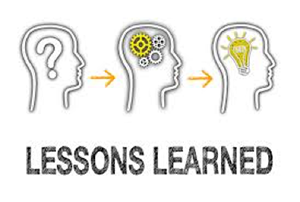
There are a number of lessons all CIOs can learn from this tale of two stories at Microsoft if they want to evolve IT from a cost center support function to a strategic business partner role within their company. It has to start with a leadership commitment to free IT’s future from the pull of its past.
Lesson One: honestly assess which step on the chart below IT resides on today.
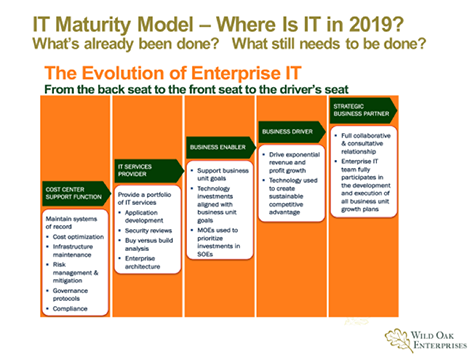
Recent studies and surveys have documented that a strong legacy mindset about IT still exists in many companies:
- 40 – 50% of CEOs and Boards still see IT as a cost center not a revenue generator
- Less than 20% of companies are using digital strategies to advance their business growth strategy
- IT spends 80% of its resources and budget on running the business and only 20% on changing the business
Lesson Two: to free IT future from the pull of its past, you have to confront these legacy mindsets head-on and build a comprehensive strategy and implementation plan to demonstrate the multiple ways IT creates and delivers business value to the organization. Here are some core questions to start that process:
- How does IT create business value?
- Does IT have the necessary skills and capabilities to deliver that value?
- What could dilute or disrupt that value?
- How can IT increase or enhance that value?
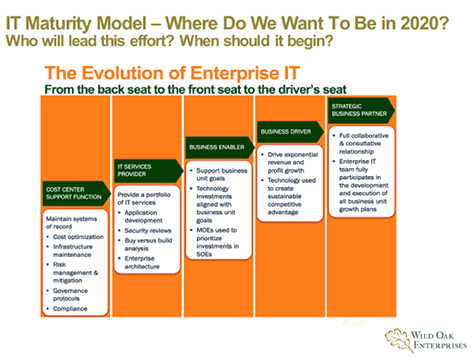
Using the 4 Zones Model to make the business value creation case for IT
In order for IT to evolve from a cost center support function to a strategic business partner role, it requires demonstrating the multiple ways technology brings business value to the organization as illustrated on the chart below. Also, here is the link to a previous blog I wrote on the different ways IT creates business value.
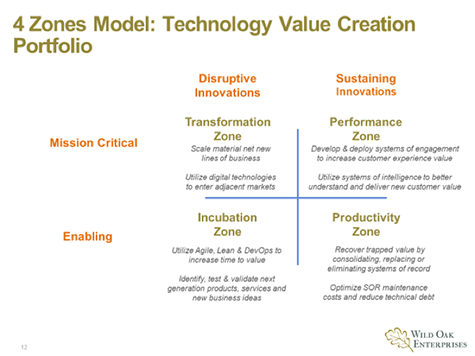
Step One: Change 80% – 20% resource and budget allocation equation

Early adopters of the 4 Zones model have started by documenting the allocation of their resources and budgets into the four zones as follows:
- % of IT resources & budget allocated to maintaining systems of record
- Productivity Zone – Run the Business
- % of resources & budget allocated to creating & deploying systems of engagement and systems of intelligence
- Performance Zone – Change the Business
- % of resources & budget allocated to identifying, testing and validating new technologies
- Incubation Zone – Change the Business
- % of resources & budget allocated to new businesses or acquisitions
- Transformation Zone – Change the Business
Early adopters then utilized our trapped value recovery and redeployment process to shift resources and budget from low value run the business functions to high value change the business functions by:
- Modernizing, consolidating, outsourcing or retiring systems of record
- Redeploying resources and budget to develop and deliver new systems of engagement and systems of intelligence
- Shifting from an 80-20% to a 40-60% allocation equation
Step Two: Redeploy IT resources & budget in new digital technologies
Many companies struggle on deciding which new digital technologies to invest in that best enable the competitive performance of their businesses. The stairway to heaven model below has provided a foundational framework and step by step path forward for making these decisions. It has been very helpful in preventing companies from just chasing the next bright shiny object.
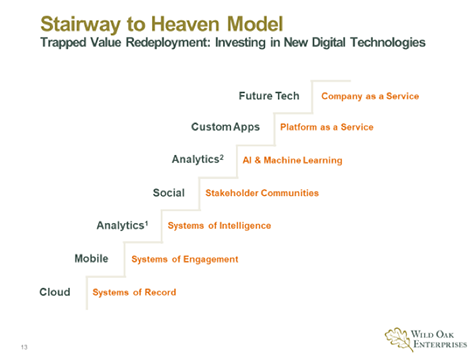
Investing in new digital technologies is a building process where the early stages on the bottom of the stairway have to be in place before the later stages can be successfully deployed. In all cases, when deciding whether or not to invest in a new digital technology, the core decision making question you must ask each and every time is “to what end?” If you can’t clearly define and agree upon the critical business outcome the digital technology will enable you are not ready to invest in it yet.
Step Three: Increase the operating performance of the company’s business units

In order to demonstrate how digital technologies can directly increase revenues, margins and profits, CIOs and their senior leadership teams have used the 4 Zones framework to align future IT investments with critical business outcomes. In collaboration with their internal business partners, they have constructed an IT Collaborative Investment Portfolio which allowed them to reach mutual agreement on how to segment and prioritize multiple IT investments by zone.
They start this collaborative dialogue by asking the following questions:
- What is currently making it difficult for you and your team to achieve your desired business outcomes?
- What can IT do to better enable your critical business capabilities?
- What new products and services are our customers asking for?
- What new digital technologies could disrupt our current customer relationships?
Armed with the answers to these questions, they can begin to talk through multiple investment options and collectively agree on those that will directly impact the desired outcomes they all want to achieve.
Freeing IT’s future from the pull of its past is not an easy task. It requires:
- Strong leadership from the CIO and senior leadership team
- The utilization of a solid strategic framework and operational transformation toolset
- A commitment to redeploy scarce resources and budget from low value run the business functions to high value change the business functions
- Tangible uses cases of technology’s ability to directly increase revenues, margins & profits
- A concentrated communication program to position IT as an investment not a cost
The good news is that the work I’ve done with early adopter CIOs and their senor leadership teams utilizing this approach has resulted in them being able to free IT’s future from the pull of its past.
If this is a journey you want to undertake, I’d welcome the opportunity to discuss how we can put this approach to work for you and your leadership team.
As always, I am interested in your comments, feedback and perspectives on the ideas put forth in this blog. Please e-mail them to me at pdmoore@woellc.com. And, if this content could be useful to someone you know please share it here:


